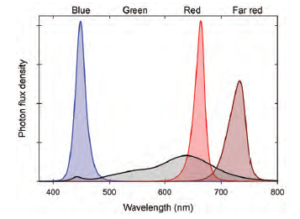Purple vs. Pink vs. White LED Fixtures
There are two primary types of light-emitting diodes (LEDs) used in horticultural applications. The first type is an LED that emits a specific color of light, such as blue light or red light (Figure 1). These are referred to as “narrow band” LEDs because their emission spectrum is within a narrow band of wavelengths.
The second type of LED emits a broader range of colors that emits a white or whitish light, and is referred to as “broad band” radiation. White light is a blend of blue, green and red wavelengths; there are no white wavelengths.
Essentially, all white LEDs are really blue LEDs that are coated with a substance (phosphors) that converts some of the blue light into longer, less energetic wavelengths. Because most lighting applications are for people, not plants, by far the greatest demand for LEDs is for white. This has led to rapid technological advances in blue LEDs to create white LEDs. As a result, the efficacy of blue (white) LEDs is now quite high while their cost has become extremely cheap.
Purple LED fixtures are usually comprised of combinations of red LEDs (usually 75 to 90 percent) and blue LEDs (usually 10 to 25 percent). There are several reasons for the development of red+blue LED fixtures. First, red LEDs have the highest efficacy, meaning their conversion of electricity into photons is high.
Second, red light has been considered the most effective at driving photosynthesis, which is true on an instantaneous basis, but we are learning that is not necessarily true over time. Third, many plants develop elongated growth under only red, and so blue is added to increase compactness and create a more typical, or sometimes shorter plant.
The major downside of red+blue LED fixtures is the potential effect on people, not plants. When there is no other source of light, such as inside a greenhouse at night, the purplish light can create an undesirable work environment. Plants don’t appear green and so detecting problems can be impeded.

Pink LED fixtures usually contain red and white LEDs, creating a less purplish, whiter light than purple LED fixtures. These fixtures are usually slightly less efficient than purple LED fixtures because white LEDs are slightly less efficient than blue LEDs. However, the spectrum is more pleasing to the eye. Obviously, the degree of whitish or purplish light depends on the percentages of white and red LEDs used in the fixture.
White LED fixtures usually contain only white LEDs, although sometimes a small percentage of red LEDs, and/or another color, is added for some reason. There are different types of white LEDs. For example, cool-white LEDs emit a slightly bluish cast, warm-white LEDs emit a softer, slightly rosy cast, and mint-white LEDs emit a slightly greenish light. The color of the white LED depends on the phosphors used to convert the blue light into green, red and far red. White LED fixtures are pleasing to the eye, although because white LEDs aren’t as efficient as blue or red LEDs, their efficacy is often lower than LED fixtures that emit a pink or purple light.
Another way to create white light with LEDs is to combine blue, green and red LEDs. However, this is usually not done because green LEDs are much less efficient than red and blue LEDs.
One final consideration is far red light, which we can barely see but promotes extension growth in most crops and flowering in some crops. With a red+blue LED fixture, there is no far red and so plants are sometimes shorter, especially during light-limiting conditions, than under fixtures that include some far red. White LEDs emit some far red, and so plants may be slightly taller, and some plants may flower slightly earlier, than under red+blue LEDs.
To summarize, there is generally a tradeoff between energy efficacy of an LED fixture and people’s preference of a light spectrum. LED fixtures that emit a purplish light are usually less preferred by people, but are often the most efficient at converting electricity into light useful to plants.
White LED fixtures create a more pleasant environment, and the spectrum is similarly useful to plants as purple light, but fixtures are usually less efficient. Red+white LED fixtures create a pinkish light that seems to be a good compromise between efficacy and lighting preferred by people.


 Video Library
Video Library 




















